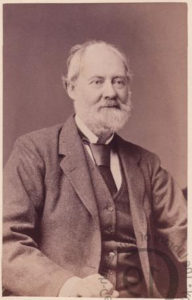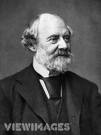
Charles Reader. Image credit: Library of 19th Century Photography
Charles Reade (8 June 1814 – 11 April 1884) was an English novelist and dramatist.
Charles Reade was a patient of James Manby Gully at Great Malvern, and he defended the water cure in his novel It is Never too Late to Mend (1856), where Reade, via his character Dr. Gullson (or James Manby Gully) explains the philosophy of allopathic overdrugging and the ‘water doctor’s‘ remedy.
As a result, people began to abandon the use of calomel, as the allopaths were quick to bemoan as it damaged their sales of this dangerous medicament.
Charles Reade’s publisher Smith, Elder & Co. also published Charlotte Bronte, Robert Browning, George Eliot, Elizabeth Cleghorn Gaskell, Thomas Hardy, Richard Jefferies, George MacDonald, John Ruskin, Algernon Charles Swinburne, Alfred Lord Tennyson and George Gissing.
He was subsequently dean of arts and vice president, taking his degree of D.C.L. in 1847. His name was entered at Lincoln’s Inn in 1836; he was elected Vinerian Fellow in 1842, and was called to the bar in 1843. He kept his fellowship at Magdalen all his life, but after taking his degree he spent most of his time in London.
Reade began his literary career as a dramatist, and it was his own wish that the word “dramatist” should stand first in the description of his occupations on his tombstone. As an author, he always had an eye to stage effect in scene and situation as well as in dialogue.
His first comedy, The Ladies’ Battle, appeared at the Olympic Theatre in May 1851. It was followed by Angela (1851), A Village Tale (1852), The Lost Husband (1852), and Gold (1853).
But Reade’s reputation was made by the two-act comedy, Masks and Faces, in which he collaborated with Tom Taylor. It was produced in November 1852, and later was expanded into three acts. By the advice of the actress, Laura Seymour, he turned the play into a prose story which appeared in 1853 as Peg Woffington.
He followed this up in the same year with Christie Johnstone, a close study of Scottish fisher folk. In 1854 he produced, in conjunction with Tom Taylor, Two Loves and a Life, and The King’s Rival, and, unaided, The Courier of Lyons (well known under its later title, The Lyons Mail) and Peregrine Pickle. In the next year appeared Art, afterwards known as Nance Oldfield.
He made his name as a novelist in 1856, when he produced It is Never too Late to Mend, a novel written with the purpose of reforming abuses in prison discipline and the treatment of criminals. The truth of some details was challenged, and Reade defended himself vigorously.
Five more novels followed in quick succession: The Course of True Love never did run Smooth (1857), Jack of all Trades (1858), The Autobiography of a Thief (1858), Love Me Little, Love Me Long (1859), and White Lies (1860), dramatized as The Double Marriage (1867).
In 1861 Reade produced what would become his most famous work, The Cloister and the Hearth. The story relates the adventures of the father of Erasmus, a subject he had dealt with two years before in a short story in Once a Week. It became recognised as one of the most successful historical novels.
Returning from the 15th century to modern English life, he next produced Hard Cash (originally published as Very Hard Cash (1863), in which he drew attention to the abuses of private lunatic asylums.
Three more such novels followed: Foul Play (1869), in which he exposed the iniquities of ship knackers, and paved the way for the labours of Samuel Plimsoll; Put Yourself in his Place (1870), in which he dealt with trade unions; and A Woman Hater (1877), in which he continued his commentary on trade unions while also tackling the topic of women doctors. The Wandering Heir (1875), of which he also wrote a version for the stage, was suggested by the Tichborne Case.
Reade also produced three elaborate studies of character: Griffith Gaunt (1866), A Terrible Temptation (1871), A Simpleton (1873). The first of these was in his own opinion his best novel. At intervals throughout his literary career he sought to gratify his dramatic ambition, hiring a theatre and engaging a company for the representation of his own plays.
An example of his persistency was seen in the case of Foul Play. He wrote this in 1869 in combination with Dionysius Lardner Boucicault with a view to stage adaptation. The play was more or less a failure; but he produced another version alone in 1877, under the title of A Scuttled Ship, and the failure was pronounced.
His greatest success as a dramatist attended his last attempt – Drink – an adaptation of Emile Zola‘s L’Assommoir, produced in 1879.
In that year his friend Laura Seymour, who had kept house for him since 1854, died. Reade’s health failed from that time. On his death, he left behind him a completed novel, A Perilous Secret, which showed he was still skilled in the arts of weaving a complicated plot and devising thrilling situations.
Reade was an amateur of the violin, and among his works is an essay on Cremona violins with the title, A Lost Art Revived.
Reade sub titled a number of his novels “A matter of fact romance;” this referred to his practice of basing his novels largely on newspaper cuttings, which he began collecting for this purpose in 1848.He also conducted his own research, observing prisons personally, for example, as well as borrowing at times heavily from other novelists’ works.
Reade’s novels were popular, and he was among England’s highest paid novelists.



Leave A Comment